Bradford-White MI30T'F User Manual
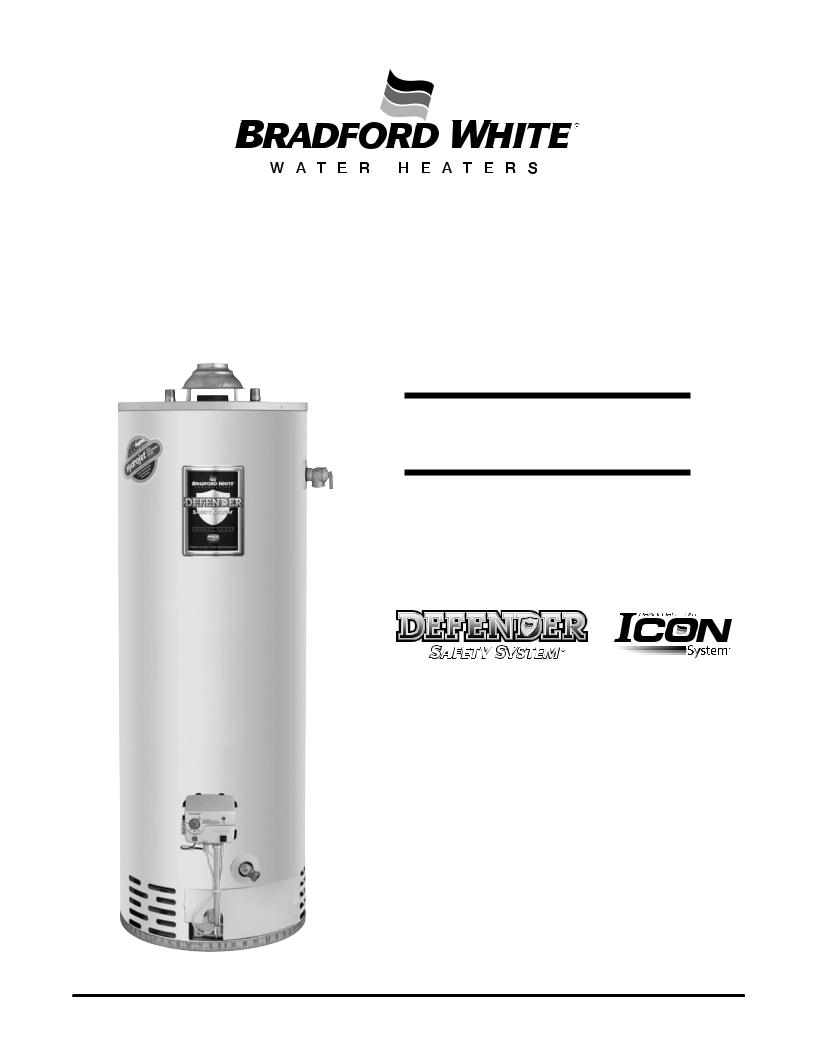
http://waterheatertimer.org/How-to-troubleshoot-gas-water-heater.html
Flammable
Resistant
Gas
S
De
Manual 238-44943-00D

Flammable Vapor Ignition Resistant Water Heaters
Table of Contents
|
Page |
Service Procedure |
|
Introduction |
3 |
|
- - - |
Trouble shooting Chart |
4 |
|
- - - |
Inner Door Gasket Removal, Inspection, Replacement and Installation |
7 |
|
RG-I |
Thermocouple/Thermopile Testing and Replacement |
10 |
|
RG-II |
Pilot Assembly Inspection Cleaning and Replacement |
13 |
|
RG-III |
Piezo Igniter, Electrode Testing and Replacement |
14 |
|
RG-IV |
White Rodgers/Robertshaw Gas Valve Testing and Replacement |
15 |
|
RG-V |
Honeywell Gas Control Testing, Disassembly, and Replacement |
20 |
|
RG-VI |
Burner Operation Inspection, Adjustment, Cleaning and Replacement |
31 |
|
RG-VII |
Resettable Thermal Switch Testing and Replacement |
34 |
|
RG-VIII |
ScreenLok® Flame Arrestor Cleaning |
36 |
|
RG-IV |
Dip Tube and Anode Inspection and Replacement |
37 |
|
RG-X |
Generic Parts List |
39 |
|
- - - |
2
2

INTRODUCTION
The Bradford White DEFENDER Safety System®
The Bradford White DEFENDER Safety System® was designed to resist the ignition of flammable vapors that can occur outside of the water heater. Use and installation are nearly identical to previous versions of atmospherically fired and vented water heaters. A number of exclusive design features are incorporated in the system that will require additional knowledge on the part of the qualified service provider. The following information will instruct service professionals on the function, proper diagnosis and repair of water heaters employing the Bradford White DEFENDER Safety System.
How the Safety System Works
During normal operation, air for combustion is drawn into the water heater through the opening in the jacket. This air travels down and around the combustion chamber and enters through holes in the very bottom of the corrosion-resistant combustion chamber. The air then travels up through the oriented flame arrestor plate louvers, where the velocity of the air is increased and its direction altered. The air then mixes in a normal manner with the supplied gas and is efficiently combusted, producing very low NOx emissions.
In the case where trace amounts of flammable vapors are present in the air flowing into the combustion chamber, the vapors are harmlessly ignited by the burner / pilot flame. If flammable vapors are in sufficient quantity to prevent normal combustion, the burner/pilot flame is shut down.
Should the flammable vapors continue to the burner, the flame arrestor plate prevents the flames from traveling backwards and igniting vapors outside of the combustion chamber. The calibrated, multipurpose thermal switch recognizes this and shuts down the pilot and main burner. This switch also deactivates the burner and pilot in the unlikely event of restricted airflow caused by severe lint, dust or oil accumulation on the arrestor plate.
3
3
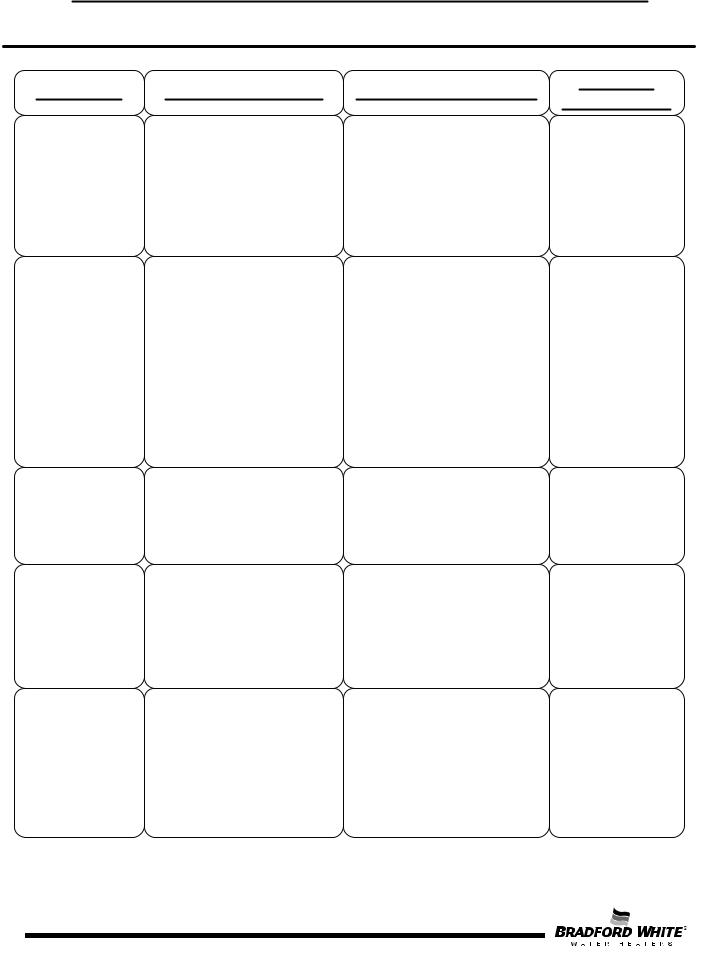
White Rodgers/Robertshaw Gas Valve Troubleshooting Chart
Flammable Vapor Ignition Resistant Water Heaters
SYMPTOM |
PROBABLE CAUSE |
Pilot Will Not Light
Pilot Will Not stay lit
when button is released
Pilot will light but the main burner will not come on
Pilot goes out periodically (after heating cycles, once a day, once a week etc.)
Not enough hot water
1.No incoming gas or too low gas pressure.
2.Gas control knob set to wrong position.
3.Pilot light button not being fully depressed when attempting to light pilot.
4.Pilot orifice or pilot tube is obstructed or kinked.
5.Pilot electrode not sparking to pilot.
6.Piezo igniter not functioning.
1.Poor thermocouple connection at combination thermostat/gas valve.
2.Thermocouple not fully engaged in pilot assembly bracket.
3.Pilot flame is not fully enveloping the thermocouple “hot” junction.
4.Weak or defective thermocouple.
5.Open ECO on combination thermostat/ gas valve.
6.Defective magnet in combination thermostat/gas valve.
7 Resettable thermal switch has opened.
1.Combination thermostat/gas valve set too low for desired water temperature.
2.Combination thermostat/gas valve temperature is satisfied.
3.Insufficient gas supply or low gas pressure.
4.Combination thermostat/gas valve has wide differential or is out of calibration.
1.Insufficient combustion air supply.
2.Incorrect, clogged vent system/ vent terminal or location.
3.Inconsistent gas supply or gas pressure.
1.Combination thermostat/gas valve set too low for desired water temperature.
2.Cold inlet water temperature is very cold.
3.High demand periods.
4.Incorrectly sized water heater for application.
5.Combination thermostat/gas valve is out of calibration/not functioning.
6.Out of spec dip tube is diluting hot water with cold water.
CORRECTIVE ACTION
1.Turn on gas supply and/or check line pressure.
2.Review lighting instruction. Set combination/thermostat
gas valve to correct position.
3.Review lighting instruction. Fully depress pilot lighting button.
4.Clean, repair or replace.
5.Verify correct electrode position. Replace pilot assembly.
6.Replace Piezo igniter.
1.Check connection at combination thermostat/gas valve. Proper tightness should be finger tight plus ¼ turn.
2.Inspect thermocouple to ensure that it is fully engaged into pilot bracket.
3.Adjust tip of thermocouple to be fully engulfed by pilot flame.
4.Check thermocouple and replace if necessary.
5.Check ECO continuity and replace combination thermostat/gas valve if necessary.
6.Check magnet operation and replace combination thermostat/gas valve if necessary.
7.Determine cause of switch activation. To reset, depress button on resettable thermal switch located on inner door.
1.Adjust temperature dial on combination thermostat/gas valve.
2.Check temperature dial setting on combination thermostat/gas valve.
3.Check gas supply and line pressure.
4.Check combination thermostat/gas valve for proper operation, replace if necessary.
1.Verify adequate combustion air is available to the unit. Check and clear Jacket slot openings of any dirt, dust, restrictions or other obstructions. Inspect flame arrestor plate and clean with stiff bristled brush and/or vacuum to remove any debris accumulation.
2.Check venting for proper sizing and proper operation
3.Check gas supply and line pressure.
1. Check dial on combination thermostat/gas valve.
2.Extremely cold water going into the heater will decrease the amount of hot water produced. It may be necessary to temper incoming water supply.
3.Adjust high demand usage.
4.Contact Plumbing professional.
5.Check combination thermostat/gas valve for proper operation, replace if necessary.
6.Inspect dip tube and replace if necessary.
SERVICE
PROCEDURE
1.See Service Procedure RG-V, Page 12.
4.See Service Procedure RG-III, Page 10.
5.See Service Procedure RG-III, Page 10.
6.See Service Procedure RG-IV, Page 11.
4.See Service Procedure RG-II, Page 8
5.See Service Procedure RG-V, Page 14
6.See Service Procedure RG-V, Page 13
2.See Installation & operation manual.
3.See Service Procedure RG-V, Page 12
4.See Service Procedure RG-V, Page 12
1.See Service Procedure RG-VIII, Page 22
3.See Service Procedure RG-V, Page 12
5.See Service Procedure RG-V, Page 12
6.See Service Procedure RG-IX, Page 23
4
4

Honeywell Gas Control Troubleshooting Chart
Flammable Vapor Ignition Resistant Water Heaters
Observe green LED indicator on Gas Control. Error flash codes are displayed with a three second pause before repeating. Check and repair the system as noted in the troubleshooting table below.
LED Status |
Control Status |
None (LED not on or flashing
One flash and three second pause
LED on continuously (Solid)
Two flashes and three second pause
Gas Control is operating normally. Pilot flame may not be present. Check for pilot flame through sight glass and light if necessary.
If set point knob is in “PILOT” position then pilot flame is detected. Turn set point knob to desired setting.
Set point knob has been recently turned to the “OFF” position. Wait until LED goes out before attempting to relight
Weak pilot signal detected. System will reset when pilot flame is sufficient.
Green LED Indicator
Probable Cause
1. Gas Control is functioning normally.
2. Gas Control is not powered. Light pilot.
3. Thermopile failure.
Gas Control is powered and waiting for the set point knob to be turned to a water temperature setting.
Set point knob was turned to “OFF” position.
1. Thermopile failure
2. Unstable pilot
3. Pilot tube block or restricted.
4. Resettable thermal switch has opened
Service
Procedure
If the pilot will not stay lit replace pilot assembly. If problem persists replace Gas Control.
Normal operation. Adjust thermostat to desired temperature setting.
LED will go out and the control will function normally when the pilot is lit.
1.See service procedure RG-II
2.See service procedure RG-III
3.See service procedure RG-III
4.See service procedure RG-VIII
Three flashes and
three second Insufficient water heating. System
will reset.
pause
Four flashes and |
Excessive tank temperature. |
|
three second |
||
System must be reset. |
||
pause |
||
|
1.Temperature sensor out of calibration
1.Temperature sensor out of calibration
2.Faulty Gas Control
1.See service procedure RG-VI
1.See service procedure RG-VI
2.See service procedure RG-VI
5
5
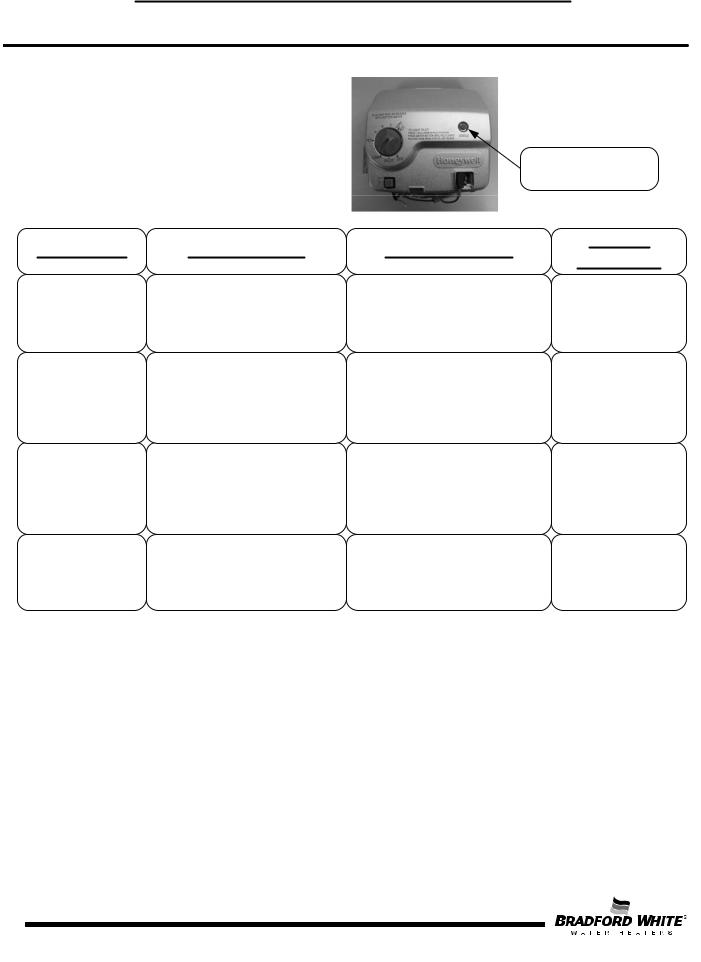
Honeywell Gas Control Troubleshooting Chart
Flammable Vapor Ignition Resistant Water Heaters
Observe green LED indicator on Gas Control. Error flash codes are displayed with a three second pause before repeating. Check and repair the system as noted in the troubleshooting table below.
Green LED Indicator
LED Status |
Control Status |
Probable Cause |
Five flashes and three second pause
Six flashes and three second pause
Seven flashes and three second pause
Eight flashes and three second pause
Thermostat/well sensor fault.
Water leak detected by accessory module.
Gas Control electronic fault detected.
Standing pilot remains on while set point knob is in “OFF” position.
1.Damage to the temperature sensor.
2.Temperature sensor resistance out of range.
Excessive amount of water in drain pan/water dam.
1.Control need to be reset.
2.Control is wet or physically damaged.
Pilot valve stuck in open position.
Service
Procedure
1. See service procedure RG-VI
1.Check T&P valve
2.Check all water fittings.
3.Pressurize and leak test tank.
1.Reset Gas Control
2.Replace Gas Control.
Replace Gas Control.
6
66
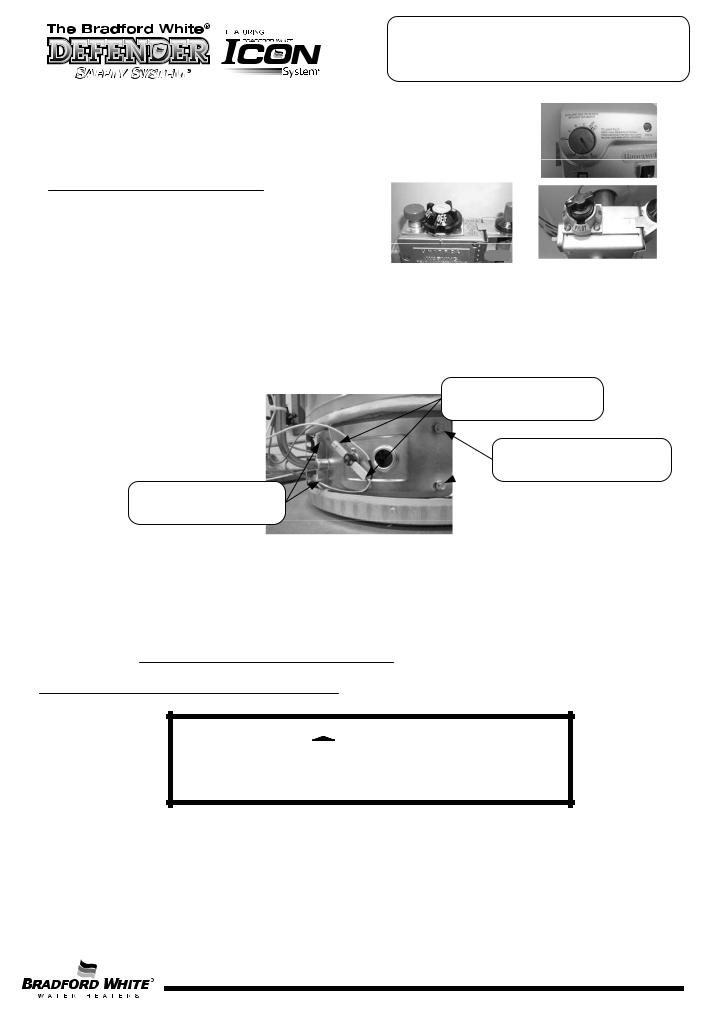
White |
SERVICE PROCEDURE RG-I |
||
Inner Door/Gasket Removal, Inspection |
|||
DEFENDER |
Replacement and Reinstallation |
||
® |
For Honeywell Control, rotate |
||
Safety System |
knob counter-clockwise to the |
||
|
“OFF” position. |
|
|
Inner Door Removal Procedure |
|
|
|
Step 1. Rotate knob of the combination |
|
|
|
thermostat/gas valve to the “OFF” position. |
|
|
|
Step 2. Remove outer jacket burner access door |
For Robertshaw Control, |
For White Rodgers Control, |
|
|
|||
Step 3. Inner Door Removal. |
depress knob slightly and rotate |
||
rotate knob clockwise to |
|||
clockwise to the “OFF” position. |
|||
|
the “OFF” position. |
||
|
|
||
a)Disconnect resettable thermal switch wire leads (leading from Gas Control/gas valve).
b)Remove (2) hex drive screws from right side inner door.
c)Remove (2) hex drive screws from flange section of inner door.
d)Remove (2) hex drive screws from left side inner door.
e)Remove inner door and inspect per step 4.
Resettable Thermal Switch
Wire Connection
Hex Drive Screws
 Right and Left Side Inner Door.
Right and Left Side Inner Door.
Hex Drive Screws at
Flange Area of Inner Door
Step 4. Fully inspect inner door gaskets for the following: |
|
>Tears |
>Other imperfections that will inhibit proper seal |
>Missing Material |
>Gasket adhesion to inner door |
>Cracks |
>Material left on combustion chamber (around opening) |
>Dirt or debris |
|
If the gasket is not effected by any of the above, gasket replacement is not required. If replacement is required, proceed to Inner Door Gasket Replacement Procedure.
Inner Door Gasket Replacement Procedure.


 WARNING
WARNING
If the information in these instructions is not followed exactly, a fire or explosion may result causing property damage, personal injury or death.
Step 5. After inspection of inner door as noted in step 4, completely remove gasket and adhesive residue from right and left side inner doors as needed.
Step 6. Use RTV sealant (recommended bead size 1/8") to secure the inner door gasket to the inner door sections (right & left). Refer to illustration on next page for proper application. Note the overlap configuration in the flange area of the inner door. Set the flange section first, this will help to achieve the proper over lap position.
7
7
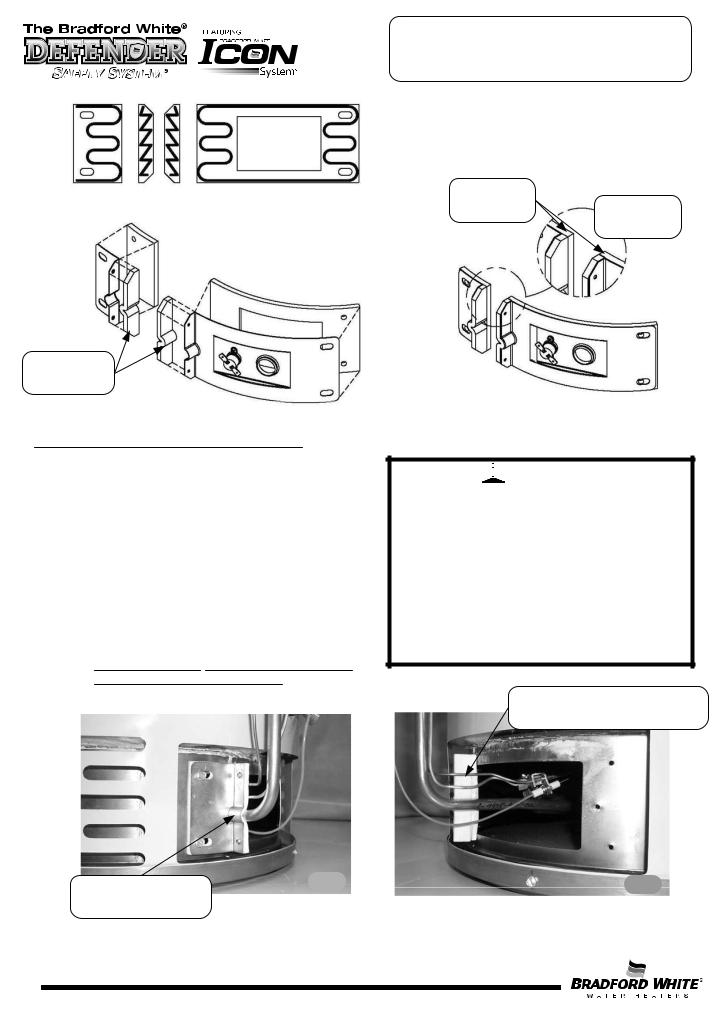
SERVICE PROCEDURE RG-I
Inner Door/Gasket Removal, Inspection
Replacement and Reinstallation
RECOMMENDED PATTERN
FOR RTV SEALANT
PLACE FLANGE
SECTIONS FIRST
EXPANDED VIEW
Installation of Inner Door With Gasket.
Step 7. Clean any residual gasket residue or other debris from combustion chamber surface before installing the inner door/gasket assembly.
Step 8. Place the left side inner door into position first. Firmly position the radiused channel of the inner door aroundthe feedline. Using the (2) hex drive screws from step 3d, secure left side inner door in place. DO NOT OVER TIGHTEN SCREWS.
Step 9 Position thermocouple, pilot tube and Piezo wire against left side inner door flange gasket.
DO NOT ROUTE THROUGH RADIUSED CHANNEL WITH FEEDLINE.
Radiused Channel for Feedline
8
GASKET
OVERLAP MUST
BE AS SHOWN |
ENLARGED |
±1/32" |
VIEW OF |
|
FLANGE AREA |
VIEW WITH GASKETS
IN PLACE


 WARNING
WARNING
Stripped fastener connections may allow for seal breach of inner door. A seal breach may result in a fire or explosion causing property damage, personal injury or death. Do not over tighten screws in steps 8, 10 and 11.
If a fastener connection is stripped, contact the manufacturer listed on the water heater rating plate.
Position thermocouple/thermopile, pilot tube and piezo wire.
88
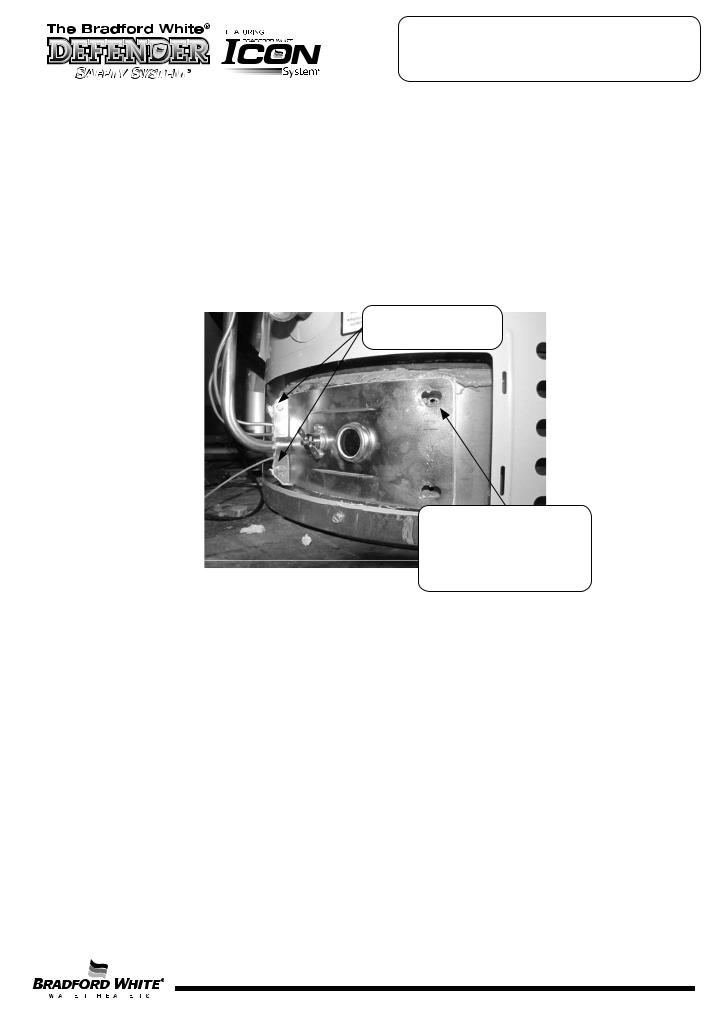
SERVICE PROCEDURE RG-I
Inner Door/Gasket Removal, Inspection
Replacement and Reinstallation
Step 10. Firmly place right side inner door flange against the left side inner door flange and secure with (2) hex drive screws from step 3c. DO NOT OVER TIGHTEN SCREWS.
Step 11. Align right side inner door to combustion chamber and verify the fastener holes of the combustion chamber are aligned with the right side inner door slotted opening. Verify seal integrity around combustion
opening. Secure right side inner door using (2) hex drive screws from step 3b. DO NOT OVER TIGHTEN SCREWS. Verify both left and right sides of the inner door are properly positioned and sealed against
the combustion chamber.
Secure flange with hex drive screws.
Verify threaded hole alignment with slotted openings in inner door.
Step 12. Reconnect lead wires from combination thermostat/gas valve to resettable thermal switch (See photo in step 3). Note, wire terminations are interchangeable with either resettable thermal switch connections.
Step 13. Replace outer jacket burner access door.
Step 14. To resume operation follow the instructions located on the lighting instruction label or the lighting instructions located in the installation and operation manual.
9
9
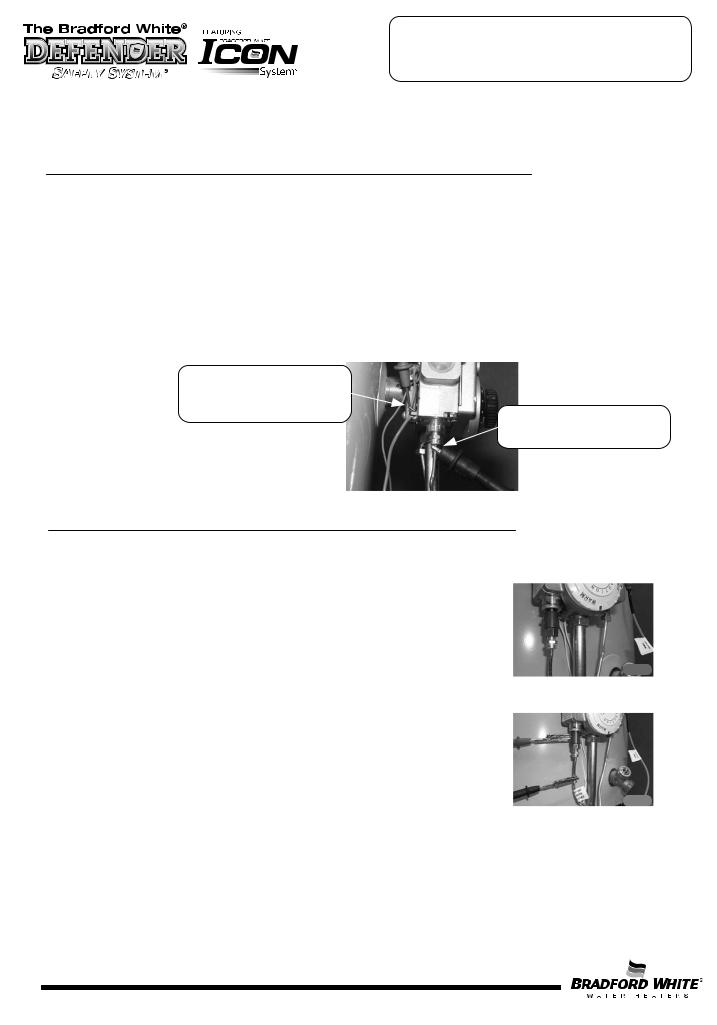
White
DEFENDER
Safety System®
SERVICE PROCEDURE RG-II
Thermocouple/Thermopile Testing and
Replacement
CLOSED CIRCUIT THERMOCOUPLE TESTING (White Rodgers Control)
Step 1. Closed circuit testing is the preferred method for testing thermocouple. Following the lighting instruction label on the heater, proceed to light the pilot and allow to operate for three minuets. If the pilot will not stay lit, hold the pilot button (located on the combination thermostat/gas valve) down during this test
Step 2. Using a multimeter capable of measuring millivolts, connect one lead
using an alligator clip to the copper sheath of the thermocouple, use the second lead of the multi meter to probe the top terminal located at the back of the combination thermostat/gas valve.
Step 3. If meter reads 10 millivolts or higher, the thermocouple is OK. If reading is below 10 millivolts, replace the thermocouple.
Probe top terminal on back of combination
thermostat/gas valve Alligator clip to copper sheath of thermocouple
CLOSED CIRCUIT THERMOCOUPLE TESTING (Robertshaw Control)
Step 1. Disconnect thermocouple from combination thermostat/gas valve.
Step 2. Connect a thermocouple adaptor
(BWC P/N 239-44642-00, Robertshaw P/N 75036) at the thermocouple location in the combination thermostat/gas valve.
Step 3. Reconnect thermocouple to adaptor. Make certain all connections are tight (finger tight plus ¼ turn)
Step 4 Using a multimeter capable of measuring millivolts, connect one alligator clip to the set screw of the adaptor, and the other alligator clip to copper portion of the thermocouple.
Step 5. Following the lighting instruction label on the heater, proceed to light the pilot and allow to operate for three minuets. If the pilot will not stay lit, hold the red reset button (located on the combination thermostat/gas valve) down during this test
Step 6. If meter reads 13 millivolts or higher, the thermocouple is OK. If reading is below 13 millivolts replace the thermocouple.
10
10
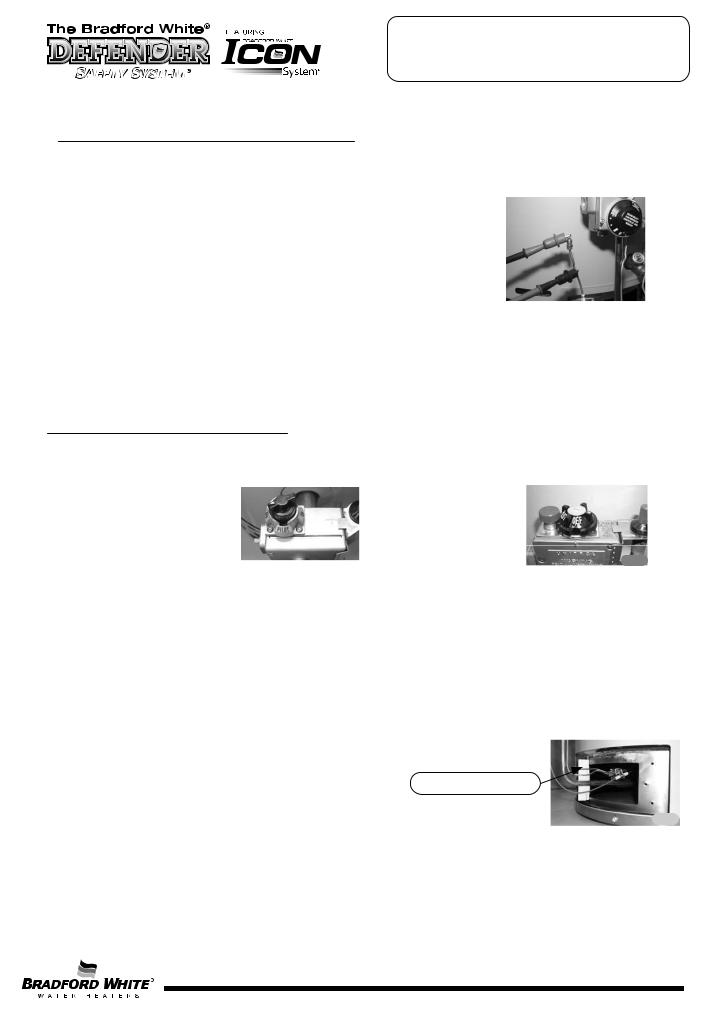
SERVICE PROCEDURE RG-II
Thermocouple/Thermopile Testing and
Replacement
OPEN CIRCUIT THERMOCOUPLE TESTING (White Rodgers/Robertshaw Gas Valve)
Step 1. Disconnect thermocouple from combination thermostat/gas valve.
Step 2. Using a multimeter capable of measuring millivolts, connect one alligator clip to the end ball or contact portion of the thermocouple, and the other alligator clip to copper portion of the thermocouple.
Step 3. Following the lighting instruction label on the heater, proceed to light the pilot and allow to operate for three minutes. It will be necessary to hold the pilot button down continuously throughout this test.
A reading of 20 to 30 millivolts indicates good thermocouple output.
THERMOCOUPLE REPLACEMENT (White Rodgers/Robertshaw Gas Valve)
Step 1. Turn off gas supply to water heater. Rotate knob of combination thermostat/gas valve to “OFF” position.
For White Rodgers Control, depress knob slightly and rotate clockwise to the “OFF” position.
For Robertshaw Control, rotate knob clockwise to the “OFF” position.
Step 2. Remove outer jacket door.
Step 3. Remove right side of inner door per SERVICE PROCEDURE RG-I, steps 3a through 3c.
Step 4 Disconnect thermocouple from combination thermostat/gas valve. Locate other end of thermocouple inside of combustion chamber and remove from pilot bracket. Pull firmly pulling away from the pilot assembly.
Step 5. Install new thermocouple into pilot bracket making certain the thermocouple is fully engaged into the pilot bracket. Position thermocouple against left side inner door flange at its original position. Connect other end of thermocouple to combination thermostat/gas valve (finger tight + ¼ turn).
Step 6. Inspect inner door gasket per
SERVICE PROCEDURE RG-I, Step 4.
Step 7. Install right side inner door per SERVICE PROCEDURE RG-I, Step 10 through Step 13
Thermocouple position
Step 8. To resume operation follow the instructions located on the lighting instruction label or the lighting instructions located in the installation and operation manual.
11
11
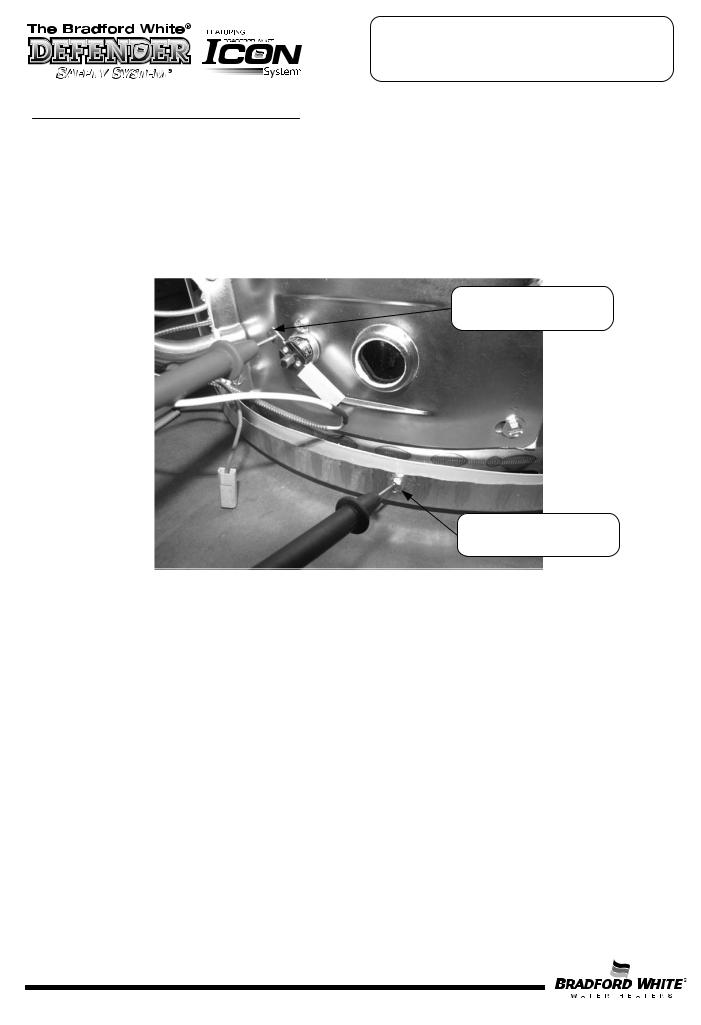
SERVICE PROCEDURE RG-II
Thermocouple/Thermopile Testing and
Replacement
OPEN CIRCUIT THERMOPILE TESTING (Honeywell Gas Control)
The following test should be performed while the pilot flame is on. Step 1. Turn knob to pilot position and depress.
Step 2. Continue pressing knob and remove red (+) wire from resettable thermal door switch.
Step 3. Using a multimeter capable of measuring millivolts, connect the positive side of the multimeter to the terminal of the resettable thermal door switch. Connect the negative side of the multimeter to any earth ground location (jacket base, screw, etc.).
Resettable Thermal Door
Switch Terminal (+)
Jacket Base Screw (-)
Normal thermopile operation will be between 350mV - 850mV. If reading is less than 350mV, replacement of pilot assembly is recommended following SERVICE PROCEDURE RG-III.
Step 4. If thermopile reading is between 350mV - 850mV, remove multimeter and reconnect red wire to positive (+) terminal of Gas Control.
Step 5. Release Gas Control knob and turn to desired setting to resume normal operation.
12
12
